Written by Charlie Hulme
Davenport Station home | Index to History pages
The large brick building on the corner of Cale Green and Adswood Lane West, Stockport is a distinctive landmark in our area.
My first thought, when I began writing this piece, was that it was commissioned as family homes for the two brothers Carrington who ran the nearby hat factory; it was on their land. However, n0 Carrington lived there until some time after it was built. The land ownership later passed to Henry Bell, along with the area's other big house, classical-styled 'Heathfield' across the road.
To reflect the semi-detached layout of the building, this page is divided in the same manner.
Cale Green House
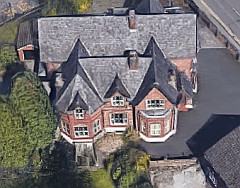
The smaller house, mostly referred to as Cale Green House (the name was on a sign on the rear door), with its frontage on to Cale Green, may have been intended for William Carrington, the other partner in the business, who never married.
He preferred to stay in the Carringtons' georgian house on Adswood Lane West (demolished after his death in 1930), which was sometimes confusingly known by the same name.
The Cale Green House described here was advertised in 1869 to let at an annual rent of £50; An 1870 newspaper entry refers to James and Elizabeth Geddes, but they didn't stay long, perhaps because their three-year-old child died there.
The next tenant we can trace, in 1871, was William Westall, aged 37 born in Oswaltwistle, Lancashire where his first three children were born. He described his occupation in detail: 'Manufacturer of Glacé cotton [a yarn suitable for knitting] and dyer of cotton yarn, employing 50 women and 7 men'. With him were his wife Alice Westall (43), John Westall (15), Christopher Westall (13), and Lily Westall (7) with two domestic servants, Esther Roberts (22) and Louis Slack (15).
The Westalls named the house as 'The Cedars', but didn't stay very long, as by 1881 it was the home of a Bank Manager, George Smith, aged 34, born in Poynton, Cheshire who is recorded in the 1881 census with his wife Jane Shepherd Smith (27), George Ernest Victor Smith (5), Evelyn Mary Smith (4), Norman Smith (2), plus a nurse Agnes Gordon (37) and a General Servant Sarah Edwards (21). The name seems to have reverted to Cale Green House. By 1891 they had left for a house in rural Prestbury.
The 1891 census lists the tenant as John William Fletcher, an electrical engineer, aged 56, born in Poynton, Cheshire and his wife Maria Fletcher, age 57, born in the distant port of Milford Haven, Pembrokeshire, tended by a servant, Elizabeth Brown. They must have been lonely in the big house, unless the rest of the family were on holiday at the time, or didn't fancy life in the Villa.
Whatever the reason, by 1901 two of their adult children, George and Mary, rejoined the family which by then had moved to 'The Homestead', a Georgian house close by which had been built for John Cale, the farmer who gave his name to the area.
In 1901 we find at Cale Green Villas (east) William E. Hodgkinson, aged 37, cotton salesman, born in Compstall, Cheshire, his wife Margaret Hodgkinson (32), their daughter Catherine Hodgkinson (3) Annie Mullard (27, cook) and Annie Hall (23, born in Scotland) a nurse and general servant.
A 1914 directory lists Frank Cressy, a commercial traveller born in Lincolnshire in 1862, who had previously lived at Park View in Cheadle. He appears in Cale Green House in the 1911 census, age 49, buyer of cotton piece goods, with his Stockport-born wife Bertha Cressy (43), their son Raymond Cressy (14) - another child had already died - and a 'general servant', Martha Brindley (23) born in Staffordshire.
(Pause for a moment and imagine the life of the sole live-in servant in a house of this kind, up at dawn to tend the coal fires, wash clothes, seven or more rooms to clean and meals to make.)
There were other Cressy families in the area at that time: Alfred, who lived and farmed at Ivy Cottage, Woodsmoor, and Robert, who lived at 11 Frewland Avenue, Davenport. All three heads of families were sons of Robert Cressy, Farmer, of Stow Green, Lincolshire.
The 1921 census offers William Bransby, wallpaper salesman, aged 60, born in Manchester, his wife Edith Lillian Bransby (44), with sons William Harry Bransby (20) a traveller in steel casement windows (perhaps for the famous Crittall company), and Victor Harold Bransby (7).
A 1934 directory lists Edgar A. Bolton, but the 1939 Register has it's one entry blacked out because the person could still be alive, so we are reaching the point where I usually cease to avoid naming private householders without their permission.
In the 1970s the two parts of the building were joined, the story continues in the right-hand column.
Cale Green Court
On 23 February 1972 in Manchester Cale Green House was offered for auction, described as a 'large semi-detached house with permission for conversion to flats, with adjoining building land with permission for the erection of flats.' A separate auction of the contents was held; one local resident recalled purchase of a carpet.

The house itself, with its partner, became a single building, as described in the main text, while the option to erect flats in the grounds was taken up, and a two-storey building with four flats on each floor, in a simple but sympathetic brick style.
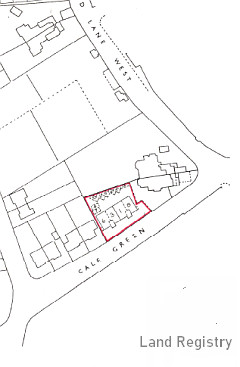
This plan shows how the flats fit into the former garden. The two pairs of semi-detached houses to the south were built on what was a pond, part of Cale Green Farm. The open area to the north was used as tennis courts; a modern care home, Bamford Close, now occupies the space.
Bricks
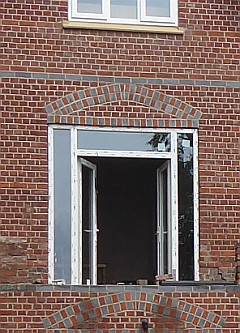
A feature of the building is that the bricks are laid in 'header bond' form, with the short side of the brick facing outwards. More expensive, and more difficult to lay, this results in a strong structure, and a characteristic appearance.
It seems to have been popular in particularly popular in the Manchester area, notably in Didsbury and Urmston. A Stockport example is the Baptist Church on Thomson Street, dating from the same period.

'Cale Green Villas', designed to resemble a large single house, was completed around 1869 by Clay and Sons of Audenshaw, who worked on a number of well-known buildings including Manchester Town Hall.
A advert in the Manchester Guardian of 28 August 1869 reads:
CALE GREEN VILLAS.- TO BE LET, TWO Very superior Semi-detached, built by Clay and Sons; one contains six bed, lumber and three entertaining rooms, butler's pantry, &c; the other four bed and two entertaining rooms, all large and airy; bathrooms, and excellent cellars; thourougly drained; surrounded by a shrubbery and full grown trees; fronts south, open aspect, very healthy neighbourhood; ten minutes walk from Davenport or Stockport stations, where express trains to and from Manchester in ten minutes. J. WEBSTER, Esq. 8, Marsden st, Manchester; or on the premises.
No. 1 Adswood Lane West
The larger house, known variously in early days as 1 Cale Green Villa, Cale Green Villas (West) and now No.1 Adswood Lane West was, according to the census taken two years later, occupied with his large family by James Bowden, born c. 1819, a 'buyer of silk goods', born in Mellor, Derbyshire. With him were his second wife Isabella Alice Bowden, aged 36, daughters Sarah Lloyd Bowden (22), Mary Elizabeth Bowden (20), Margaret Allen Bowden (10), Isabella Gertrude Bowden (5), and sons George Alfred Bowden (11), Percy Gray Bowden (8) and James Hubert Bowden (1). They had a General servant, Sarah Powell, aged 16. They had previously lived in Mayfield Grove, Cheadle Hulme. by 1891 James had retired and they had moved to a smaller house, 'Daisy Bank' on the main London road. James died in 1895.
The Bowdens were still there in 1881, but a directory published in 1883 lists Miss Elizabeth Bryan, who may have been the lady (born 1843) who in 1881 is listed living in Disley with a cook and housemaid for company. She can't have liked it much as it was advertised to let in September 1884, and again in 1887.
The tenant by 1891 was Henry Turner JP (1834-1905), Captain of the Cheshire Militia, Calico printer employing 300 men, Magistrate for Stockport and Derbyshire. He was a son of James Aspinall Turner (1797-1867) a cotton manufacturer and Whig MP for Manchester between 1857 and 1865. He was elected Mayor of Stockport in 1891. Before Cale Green, he resided at 'Woodlands', a large mansion in Offerton with large grounds on which he engaged in horse breeding. The house, which was used to house 'GIs in World War 2, and became a 'special school' in the 1950s no longer exists, and the grounds have become a park and a housing estate. For more about the Turners and Woodlands, see the marvellous Stockport in 100 Halls blog.
Henry had retired from business, aged 56, when he came to Cale Green with his wife, Alice Woodcock Hopkinson Turner (46). They had no children, but in 1891 their six bedrooms more than accommodated two nephews, Robert Woodcock Naylor Winstanley (21) and William Henry James Winstanley (19). They had two servants, Rachel Knoll (57) and Elizabeth Griffiths Pennington (19). By this date, the trend for employing servants from distant rural areas was fading: both hailed from Stockport.
The two nephews went on to professional careers, Robert became an Architect, and emigrated to Australia wheer he died in 1960, while William trained as an analytical chemist, a career interrupted by suffering the First World War as a Captain in the Royal Army Service Corps; he lived until 1967
By 1901 Henry and Alice had escaped to rural Lancashire to a house called 'Chadswell' in the village of Chaigley, near Clitheroe in the Hodder Valley, taking with them a niece, Alice Winstanley, and Elizabeth Pennington the cook from Cale Green; clearly her cooking was appreciated. There was also a small army of other servants - two housemaids, two waitresses, a coachman, a carter and a gardener. Henry Turner died in 1905.

A postcard view of Cale Green in Edwardian times. On the left is Cale Green Post Office. The large, but rather plain windows of the Villas are a distinctive feature. By this date, the promised 'very healthy neighbourhood' was perhaps so. The area is higher than the town centre which lies in the valley of the Mersey, but industry was encroaching.
In 1893, Walter Thomas Carrington, born in 1854, joint owner of the building, who had been living with his brother William in the old family house on the other side of Adswood Lane West, married Lucy Ellen Battersby and occupied the Villa. The two brothers were the owners of the adjacent Carrington Hat works, as described in our Cale Green Park feature along with more about Walter. In 1901 the household included Lucy Ellen Carrington, their daughter Joan Shelley Carrington (age 5), Georgina Ratcliffe Carrington (4), Nurse Annie Sykes (36), Under-nurse, Lenora Kitchen (18), waitress Agnes Davenport (20) and cook Lily Meachin (18). In 1908 Walter Carrington died, and the house became vacant.
The next tenant was Dr George Pouncey Henderson (born 1874 to William Henderson and Mary Pouncey) and the house became a doctor's surgery as well as a home, a twin role it would fulfil for many years. In 1911 26-year-old Dr Henderson, born in Redcar, Yorkshire, was living in the Villa with his wife Helen Henderson (aged 34, born in Stockport) and their seven-year-old daughter Nellie Henderson as well as Ethel Evans, born in Stoke, Staffordshire, general servant.

George came from a wealthy family: His father William, born in Aycliff, Durham was a 'Steamship owner and broker'; in 1881 he lived in a large house in Linthorpe, Yorkshire with his wife, five children and two servants. Helen was a daughter of Edwin Rayner, a Stockport doctor who achieved national fame in the medical world, and really needs a website all to himself. He and George Henderson were sharing a practice in Tiviot Dale, Stockport town centre at the time of Helen's marriage: he was living at 25 Tiviot Dale and the Rayners at no.19. During the first world war, George volunteered at the Sir Ralph Pendlebury Auxiliary Hospital.
(A famous Stockport Rayner at the time of writing is Angela Rayner MP.)
In 1922, the Carringtons sold the freehold of the building, and Dr Henderson, who had been renting at £57 per annum, purchased it (confusingly described as no.2 Cale Green Villas).
Helen Henderson died in 'Elmfield', a Manchester nursing home, in 1929; George re-married, to Mavis Smith, in 1932. He is listed in a Stockport directory for 1934, but by 1939 they had moved to the Bideford area of Devon. George died in 1952, while Mavis lived until 1982. They are buried together at St Swithun's Church, Littleham, Devon.
The house and practice in Cale Green were taken over by Dr John J Rippey, born in 1904, and his Physiotherapist wife Dorothy Rippey, born 1903. John James Rippey was an Irishman, born at Sion Mills, County Tyrone, youngest son of a farmer (also John James), and Mary Rippey, and educated at Foyle College, Londonderry, and Queen's University, Belfast. They appear at the Villa in the 1939 register, with a child whose details redacted as possibly still alive. Dr Rippey carried on the practice through the dark days of World War 2 and until 1947 when they moved away from the area. Dorothy Rippey died in Malta in 1966, and John James Rippey died in London in 1977.
The final doctor to practise at no.1 Adswood Lane West was perhaps the most interesting: Sir Roger Carroll Patrick Stephen Bellingham, 6th Baronet, who qualified as a doctor in 1936, and came to Stockport from a post in a Shrewsbury Hospital. (The name is supposed to be pronounced with a soft 'G'.) His Stockport address appears in the Telephone directory for the first time in 1948. Born on 23 April 1911, he was a nephew of Captain Roger Charles Noel Bellingham and Alice Ann Naish. He married Mary Norman, daughter of William Norman, on 27 December 1941. He became the 6th Baronet in 1956 on the death of his uncle, Sir Edward Henry Charles Patrick Bellingham, the last Bellingham to live in the Castle, who had a daughter but no sons.
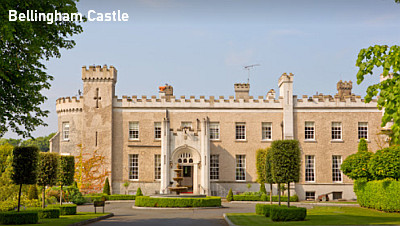
The Cale Green house is a large one, but not as large as Bellingham Castle, in County Louth, Ireland which was the ancestral family seat, making him the owner, although he never lived there. It was left empty after his death until sold in 1958 and converted to a hotel, which today is a popular wedding venue.
Sir Roger was still in living in the Villa until shortly before he died in 1973. The Baronetcy passed to his two sons, born in Cale Green: Sir Noel Peter Roger Bellingham, 7th Baronet born 1943, and when he died in 1999 to his brother Sir Anthony Edward Norman Bellingham, 8th Baronet, born in 1947, who died in 2015. At the time of writing, the title is held by the 9th Baron, Sir William Alexander Noel Henry Bellingham, son of Sir Anthony, born in Los Angeles in 1991.
A Baronetcy is an honour similar to a knighthood, but different in that once conferred it is inherited on the death of the holder; it does not give the right to sit in the House of Lords. This one was created in 1796 for William Bellingham, MP for Reigate and private secretary to William Pitt the Younger.
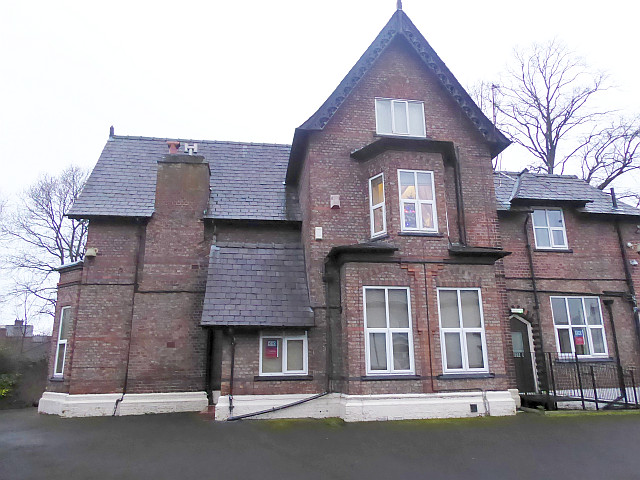
An auction of the other part of the building, latterly known as Cale Green House, was held in 1972; see opposite column. Above is a view from the side: Cale Green House is the left-hand part of the building; its frontage is on a private drive. It's not clear how the Bellingham part was sold, probably by a private sale, but the whole building eventually came into the hands of the Sisters of Charity of Our Lady of Evron, a Catholic religious congregation founded in 1682 by Perrine Brunet in Mayenne, France. The congregation was dedicated to 'teaching and the care of the sick, especially of the poor, while at the same time becoming more open to God' .
The congregation, which had a number of communities around the Britain, including Romiley, Stockport, named the building 'Shalom' An item in the Manchester Evening News in 2003 explained:
Set behind high brick walls and shielded by large conifers is the Shalom centre - a Catholic retreat open to all Christian groups. The building has been the base for Shalom - meaning "welcome" and "we wish the very best for you" - for over 20 years.In 2009 the place was re-named the 'Evron Centre'. It also provided residential accommodation for the Sisters. A few years later, they closed the centre, which must have had a high maintenance cost, and it was offered for sale. In 2020 it was sold for £810,000, apparently to return to domestic use by a 'large family.' At the time of writing (2022) some work had been done on the building, and stopped again as it was without the planning consent required as it is in the Cale Green Conservation area.
Carers in Stockport have come to rely on Shalom. Oasis for Carers, which runs on Tuesday mornings and afternoons, is devoted to looking after those who dedicate their lives to family or friends and have very little time to look after themselves. Carers can relax with aromatherapy, meditation and massage. Thanks to a donation from an anonymous benefactor, the centre has recently undergone a complete transformation. It now includes purpose-built facilities such as a jacuzzi bath for the carers and a commercial kitchen. The Sisters have organised a series of talks and events to be held in the new chapel, which can now hold up to 50 people.
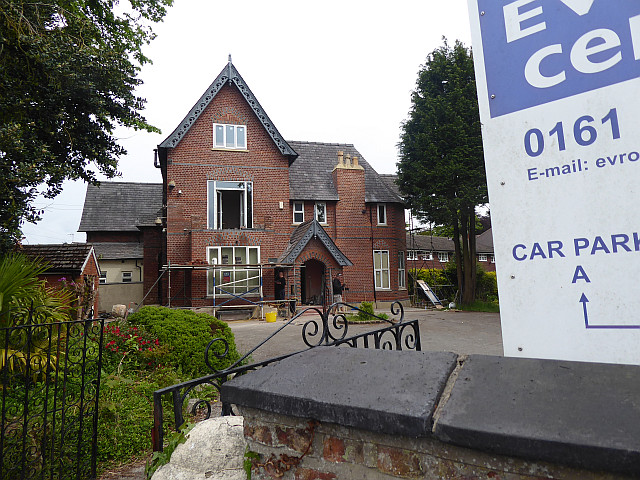
Sources used
Nothing appears to have been published about these houses; I've used both Ancestry and Findmypast to try to locate all the residents, some with great ingenuity required, as well as the British Newspaper Archive and the online Manchester Guardian available to members of Greater Manchester libraries. The Medical Register has been of great help regarding the Doctors. Google Maps and the National Library of Scotland are essential as always, as was the Land Registry. Our own collection of Street Directories, although not always accurate, have filled in the dates between censuses.
The story of Castle Bellingham in an Irish newspaper can be downloaded here.
Special thanks to Cale Green resident Adrian Harrison for assistance and for encouraging me to write this feature.
Written by Charlie Hulme, February 2022. Comments welcome at
charlie@davenportstation.org.uk